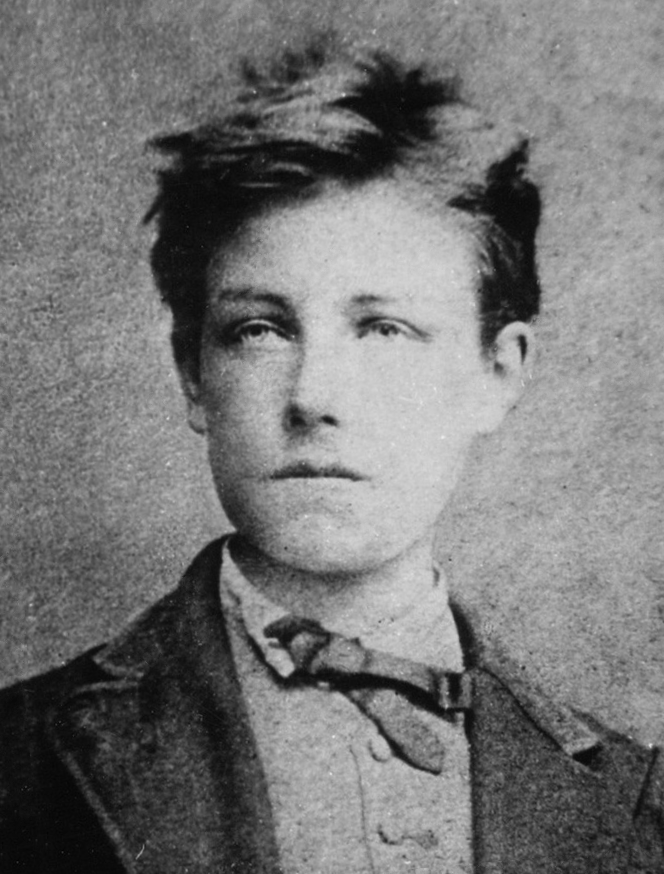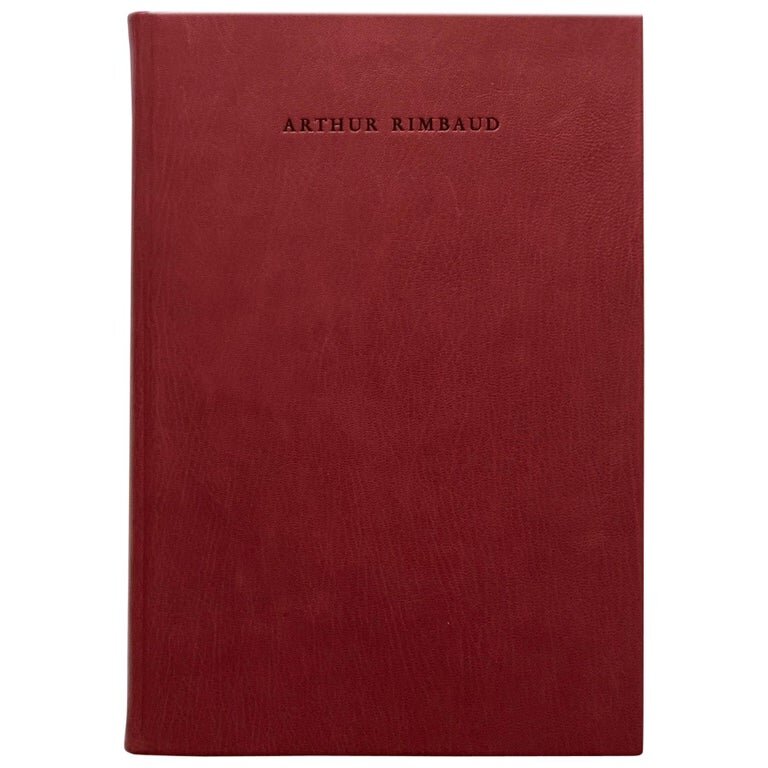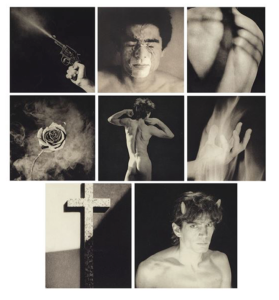Translated by: Ravita Buaphaun
“Love has to be reinvented, we know that.”
Arthur Rimbaud, A Season in Hell
Who do you think of when it comes to iconic gay photographers? It would be hard to not mention Robert Mapplethorpe who conveyed the aesthetic of gay community subculture in the ‘70s with Sadism-Masochism connotation. As for poets, a lot of people might think of Arthur Rimbaud, a French poet who composed the masterpiece A Season In Hell with inspiration from his relationship with a legendary poet who was relatively his father’s age. Both Mapplethorpe and Rimbaud were artists who bravely talked about their gender identity. They both produced artwork that circle around a hectic relationship, and shared another similarity of having such a short span of life.
With these two things in common, both artists were destined to come across even though Rimbaud had passed away in the year 1891, before Mapplethorpe was even born. This is because the poem A Season In Hell of Rimbaud was translated from French to English by the year 1986, the era in which Mapplethorpe was experiencing a breakthrough in his photography career. It was also the only poetry book that Mapplethorpe decided to shoot photos for.
Correspondingly, this article would like to invite you to discover how Robert Mapplethorpe met Arthur Rimbaud, and how Rimbaud’s years in “hell” turned into a poem that brought the two of them together.
Robert meets Arthur
Years between 1980-1990 were regarded as the period where we had lost the world’s greatest artists, writers, and a number of creators on account of AIDS. One of them was famous singer Freddie Mercury, the world’s major philosopher Michel Foucault, Sci-Fi writer Isaac Asimov, rising star Félix González-Torres, and also Robert Mapplethorpe, an American photographer who was at the peak of career with his black-and-white photography. From portrait, self-portrait to still life photos, they are all astonishingly attractive and captivating with his creative process. Some critics entitled them as modern sculpture photography which combines the classical aesthetic elements to the sarcastic, cynical, morally challenging aesthetic in the way of modern art.
The Perfect Moment (1989) an exhibition which compiles Mapplethorpe’s archive throughout his career was held only one month prior to his death. It was considered one of the most important moments in the history of photography when one of his collection has unveiled the subculture of gay community in leather suits with chains, whips and handcuffs in their hands, including explicit sexual intercourse scene. Also, his nude photography of children that was labeled as Child pornography created controversies in the society, turned into a lawsuit and eventually resulted in the exhibition being canceled.
Robert Mapplethorpe was a native New Yorker, born and raised in a conservative Catholic family, being one of five siblings who was outstanding since he was a kid. His interest in art got him to apply to the prestigious art college like Pratt Institute in the Department of Painting. He was also an ex-lover of Patti Smith, an American female poet and singer who once worked at a bookshop in order to accompany Mapplethorpe while he was chasing his dream. Though separated, the two remained comrades who looked for each other until the end of their time.
Mapplethorpe discovered the charm of photography by the end of 1960. He started with Polaroid camera before moving to Hasselblad, a medium format camera which he received from Sam Wagstaff, an art curator who later became his friend, lover and the person who brought Mapplethorpe into the circle of artists and famous persons in different industries.
If there was someone who influenced Mapplethorpe both directly and indirectly, the person must be George Dureau, an American artist who worked on both paintings and photography. His work that left an impression on Mapplethorpe was his series of the beggars, the dwarfs, and the people with disabilities, which Dureau could illustrate the expressions in their eyes and their liveliness excellently. We could also see traces of his influence in Mapplethorpe’s portrait photography, especially the posture and manners of the models that look as if they were living statues.
Mapplethorpe’s innovativeness and uniqueness brought him to the attention of the academic world in the early 1980. His name was mentioned significantly in a number of photography textbooks, whether La Chambre claire: Note sur la photographie (1980) or Roland Barthes’s Camera Lucida as an artwork that draws the line between pornographic photography and erotic photography, especially his self-portrait.
Camera Lucida referred to Mapplethorpe’s photographs as a great case study for ‘lesion’ of ‘effect’ on the audiences’ mind, which Barthes defined it with the term punctum, the details taking place in an individual’s view of the image, which does not occur in the case of nude photography that can go the furthest as being ‘interesting’ or as Barthes called studium. Barthes saw that this feature contains linguistic, cultural and political connotations more than emotions or personal experiences. For this reason, Mapplethorpe’s photography is not indecent according to Barthes. The ability to transcend the convention of explicit genitals exposing as appeared in common pornographic photography has an impact on visual perception and emotions. Mapplethorpe’s photos therefore need to be filled with feelings, memories or external contexts outside the photos.

Robert Mapplethorpe, Self Portrait (1975)
It was in 1986, the highest point of his lifespan before getting diagnosed with AIDS that he was commissioned to shoot eight black-and-white photos for an important poetry book of the 19th century called Une Saison en Enfer or A Season in Hell by Arthur Rimbaud, which was by then re-translated by Paul Schmidt. It was a poem that conveys Rimbaud’s years of being in a relationship that was as painful as inferno.
The reason for him to accept this job could be that Rimbaud was one of the most significant influences on Patti Smith, who was at that time still living with him.
According to Patricia Marissoe, author of Mapplethorpe, biography book of Mapplethorpe, Rimbaud was Patti’s love at first sight once she saw his face on the cover of Illuminations. No wonder that she would see Mapplethorpe as a real life avatar of Rimbaud, or at least she should have taken part in changing and modifying the young Mapplethorpe’s image to be more charming in an angelic way.
Eight monochrome photographs processed using Photogravure technique were placed between chapters and intro pages as an interpretation of each chapter. One remarkable photo from the collection was the self-portrait of Mapplethorpe in the images of ‘angel’ and ‘demon’ who turned his gaze towards the audience.
As both of them were rebellious artist-poet or bad kids (enfant terribles) in their respective industries, the encounter of Mapplethorpe and Rimbaud was truly a wonder (at least for the writer)
Arthur meets ‘Hell’
Arthur Rimbaud was born in Charleville, a town in the northeast of France close to the border of Belgium. His talent in poetry started to shine when he wasn’t even 10 year old. After turning 14, his poetry in Latin received first prize in a contest.
Rimbaud’s family was not very wealthy like most merchants. But at least his mother encouraged him to study as much as possible. So Rimbaud got to read extensive genres of books from poetry, Greek-Roman philosophy all the way to thick History books.
Nonetheless, Rimbaud could not afford all the books as he liked, so he usually read at bookstores. One of his most favorite books is a poetry journal Le Parnasse contemporain which was a liberal journal that compiles all the notable poets from the 19th century like Charles Baudelaire, Stéphane Mallarmé and Paul Verlaine. At that time these poets were considered as progressive writers of the era. These poets whose works were published in the journal were casually called the Parnasse, or the Parnassus, derived from the name of the valley where the muses live according to Greek mythology.
It is certain that Rimbaud’s work has never been published in the poetry journal Le Parnasse contemporain but surely he was heavily influenced by the Parnasse. Especially Paul Verlaine, who was a tutor, a comrade and a lover to Rimbaud. Verlaine called the young poet ‘fallen angel’ for his lovely hairstyle and face, looking like an angel more than a demon. Verlaine was deeply in love and passionate about Rimbaud’s existence and capability in poetry, which was apparently comparable to the senior poets in the Parnasse.

Étienne Carjat, Arthur Rimbaud (1871)
However, as the relationship between Verlaine and Rimbaud proceeded for a year, with working, traveling and extreme kinds of lifestyle both in Paris and London, it reached the point where the couple started to quarrel every single day. Rimbaud became an angel from hell for Verlaine most of the time. Verlaine’s mood swings from being depressed to furious make it difficult for both poets to cohabit. One day, Verlaine who often threatened to kill himself fired a shot at Rimbaud, leading to an arrest and two years’ imprisonment for Verlaine, also the end of their relationship.
The love story between him and Verlaine is the origin of the tragedy in Rimbaud’s A Season in Hell. He wrote the poem throughout their stormy relationship. Once it was over, Rimbaud brought back the manuscript of A Season in Hell, finished and published it with his own money. Throughout his life, It was the only poetry Rimbaud published by himself.
On one hand, it can be said that his loss of reputation from being in an immoral relationship with Verlaine was the reason for the critics’ harsh comments on his work. But on the other hand this can be seen as a step out of the Parnasse’s influence who craved for the traditional, classical way of extravagance to modernity. A “completely modern” point as appeared in A Season in Hell was extremely progressive, or in itself a critique and a strike to the obsolete Parnasse whose work was attached to a stylish verse, judging by how Rimbaud composed this poetry in a style of prose, not verse.
A part from the poetry reflects an oppose to the traditional value of heterosexual love (which nowadays can be easily seen as sexism if read without knowing the context), also an origin of the famous quote “…Love has to be reinvented”
“I don’t like women. It is certain that love has to be reinvented. All women do is long for security. Once gained, love, beauty and everything else are set aside: only cold disdain remains, the marriage life nowadays. As I see women, with the marks of happiness, with whom I could have made into fine comrades, but devoured from the start by brutes as sensitive as posts…”
The ‘Hell’ Until Now
A Season in Hell was a rebellious work both for its style and content. As Albert Camus, a Nobel Prize winning author had proposed that although A Season in Hell was not well-received during its own time, it was a foreshadow for the monsoon of change which was forming in the early 20th century. The ones who succeeded it were the Surrealist writers and poets, who regarded Rimbaud as one of their ancestors.

Arthur Rimbaud, A Season in Hell (1986)
Through this, the A Season in Hell book which was published featuring Mapplethorpe’s photographs in 1986 was one small phenomenon that left such a great impact. As it was the encounter of two persons who attempted to create artwork and ‘love’ in a new aspect, an artwork which was received in their era as a challenge, a taboo or even an unspeakable truth.
Reference
-Banham, G. (2002). Mapplethorpe, Duchamp and the Ends of Photography. Angelaki, 7(1), 119–128. doi:10.1080/09697250220142083
-Chryslee, G. J. (1995). When the Scene Becomes the Crime: Censorship of Space in Cincinnati’s Exhibition of Robert Mapplethorpe’s Photographs. Free Speech Yearbook, 33(1), 116–127. doi:10.1080/08997225.1995.10556186
-Meyer, R. (2001). Mapplethorpe’s Living Room: Photography and the Furnishing of Desire. Art History, 24(2), 292–311. doi:10.1111/1467-8365.00265-Rimbaud, Arthur; Schmidt, Paul; Mapplethorpe, Robert (1997). A Season in Hell. Boston: Little, Brown.


